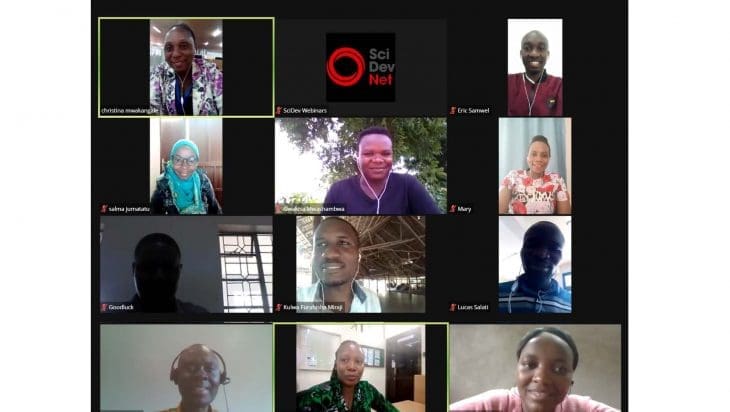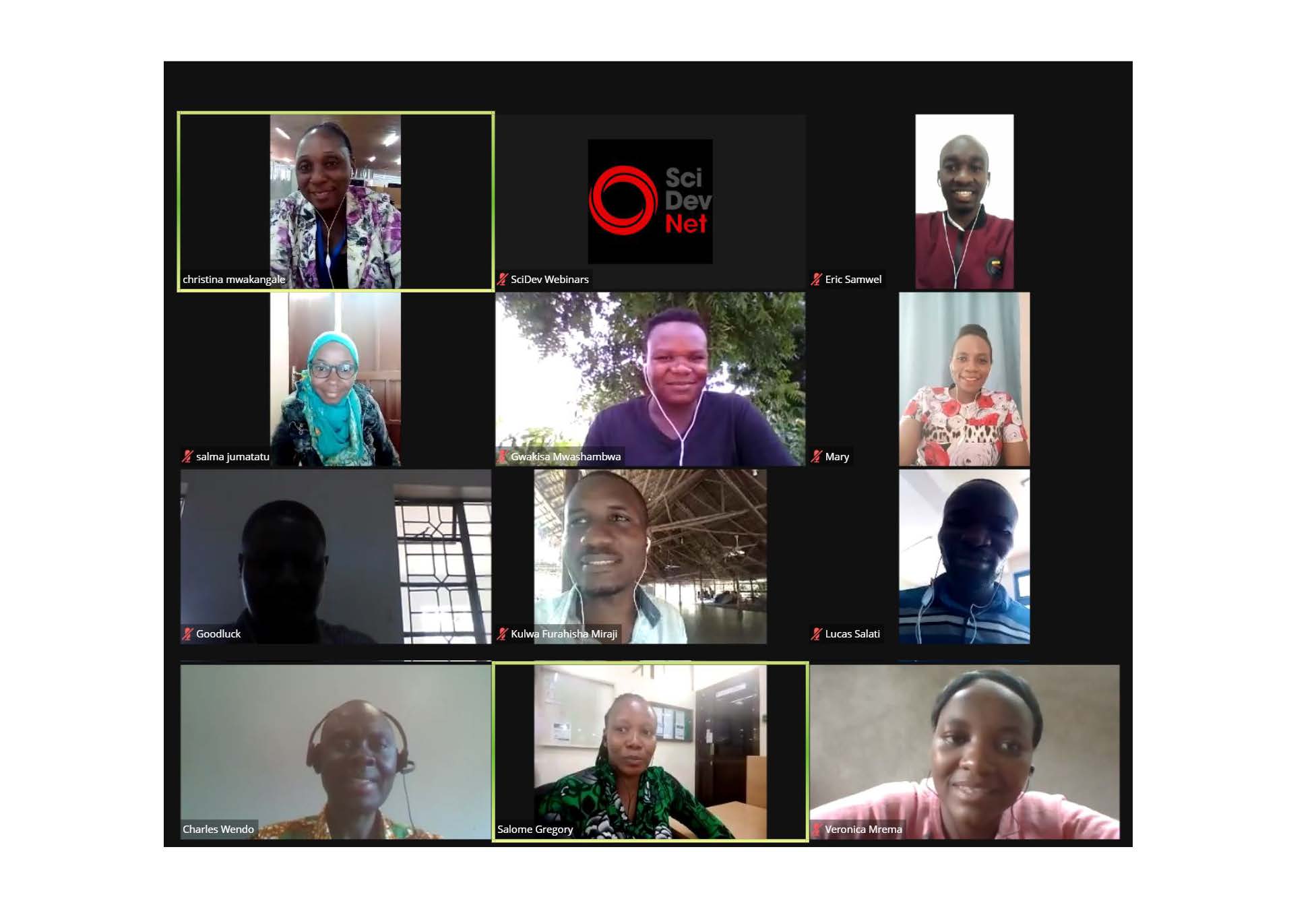Researchers convince journalist their studies are newsworthy


Image: Dr Charles Wendo hosts an online speed-dating session between University of Dar es Salaam researchers and a Tanzanian science journalist.
04/03/22
Blog
Researchers convince journalist their studies are newsworthy
Speed read
Researchers from the University of Dar es Salaam took part in the Script online speed-dating session
By Charles Wendo
How can a scientific researcher convince journalists within 2-3 minutes that their study is worth reporting on? This has been one of the topics covered in media skills training conducted by SciDev.Net’s training programme, Script.
From 24th to 28th January 2022, it was the University of Dar-es-Salaam’s turn to receive training. It was the ninth in a series of Sida-funded research communication trainings for scientific researchers in developing countries.
The scientific researchers spent on average two hours a day for five days to complete the online course modules and attend webinars. The topics covered included communicating scientific research in simple language and making research findings interesting to the media, public and policymakers. Other topics were structuring a media article about scientific research and using social media to communicate findings. The training also covered how to communicate effectively with different audiences.
Tips on how to pitch
To give the scientific researchers an opportunity to practise what they learnt, Script programme arranged for a ‘speed-dating’ event. The session began with a recap of how to successfully pitch research findings to a journalist. In summary, below were the tips.
- Pitching research to journalists is about instantly convincing them that findings are interesting, important and timely enough for them to report on.
- Journalists want to hear about research findings on matters of interest to the public and policymakers. They want the information in simple language so they can easily understand it. They also want you to reveal facts or views that were not widely known before.
- It’s important for scientific researchers to share with the media only findings that have been peer-reviewed and published. Unpublished research may not amount to credible scientific evidence.
- Go straight to the point. Straightaway state the main conclusion of the research and its implications for society. Explain the urgency – that is – why the public should know about the findings immediately.
- In pitching, the intention is to quickly make the journalist interested in reporting your findings. If the scientific researcher makes a successful pitch, then the journalist can arrange to interview them for more information
Three minutes with a journalist
Seven scientific researchers participated in the event, out of 33 that attended the training. Each of five journalists sat in a Zoom break-out room. One or more researchers joined the journalist in each breakaway room. Typically, the session began with 1-2 minutes of greetings, introductions and exchanging contacts. Each scientific researcher then spoke about their study for 2-3 minutes. And finally, the journalist asked some questions if anything was not clear.
After five minutes, every scientific researcher was moved to a new break-away room to meet another journalist. This gave each researcher an opportunity to pitch their findings to 2-3 journalists.
One scientific researcher did not have their own findings to present. However, they had newsworthy information based on a review of various research studies on the topic.
What the journalists thought about the session
At the end of the session, journalists stated that all the findings pitched to them were potentially newsworthy. However, this was a training session and not a news-making event. Journalists were free to, but not required to report news on the studies they heard about during the event.
Both journalists and scientific researchers said they had made useful contacts. Scientific researchers were particularly happy for an opportunity to meet journalists and pitch to them their findings. Some of them had never met a journalist before.
What the researchers thought about pitching to journalists
For Kulwa Furahisha Miraji, Researcher at Tanzania Agricultural Research Institute, it was the first opportunity to pitch to a journalist. “When I was told to pitch within less than five minutes, my conscience was that the time was too short. I started to figure out how to summarise the information and to my surprise, I finished within two minutes. This first experience helped me to make a better pitch when I went to the second journalist,” he said.
Similarly, Dr. Suma Kibonde, a lecturer of Geography and Environmental Management, stated: “This has been very good and practical. In the first pitch I did not do well, the journalist had to guide me. This helped me to perform better in the second pitch.”
Script speed-dating
Speed-dating has been a key component of Script programme’s training since 2018. The first speed-dating event was in March 2018 during the Next Einstein Forum in Kigali. Since then Script, has carried out more than 10 other training-related speed-dating events, often with modifications to suit the circumstances. For instance, where we had more scientific researchers than journalists, it took the form of speed-pitching. In speed-pitching, the journalist met more than one scientific researcher at once.
A key lesson from speed-dating events is that scientific research findings are often newsworthy. A second lesson is that often, researchers are happy to share their findings with the media and public.
However, journalists often do not know where and when researchers have newsworthy findings. Similarly, researchers often do not know where and how to find the right journalists to report on their research. Therefore, scientific researchers and journalists should continually engage for mutual benefit and for the benefit of society.
Indeed, effective communication can help scientific researchers to contribute better towards national development. “The challenge we have, which has been echoed by the Prime Minister, is that we conduct research but we are not that effective at communicating the findings. So, most of the research remains with us,” said Dr. Mathew Senga, Research Grant Coordinator at the University of Dar es Salaam. “ This training has given us the skills and confidence to communicate research findings. I hope we can organise more trainings of this nature in future.”
Dr. Charles Wendo is the Training Coordinator for SciDev.Net



